
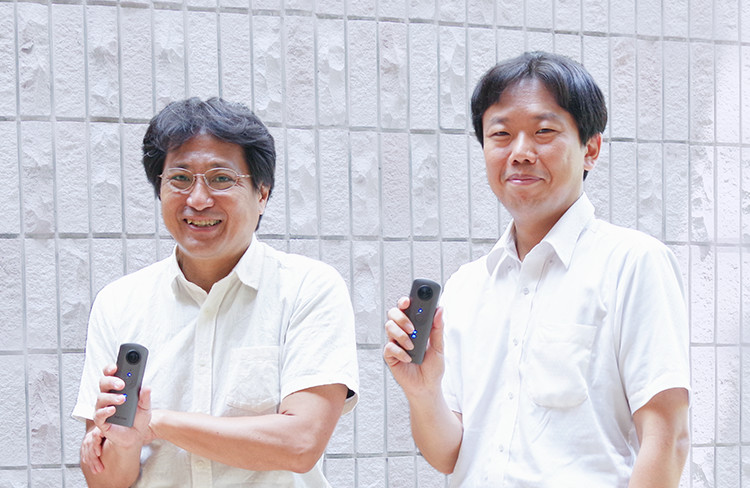
Vol.3
RICOH THETA Developer Interview
What are function extensions?
Ask the developer.
Ricoh Company, Ltd.
Ryoh Fukui (Left)/Masato Takada (Right)
“Using THETA, you can display video directly onto a TV or similar equipment. Remote Playback is the world’s first function to achieve this.”
First, can you give me an overview of the “Remote Playback” introduced with THETA V?
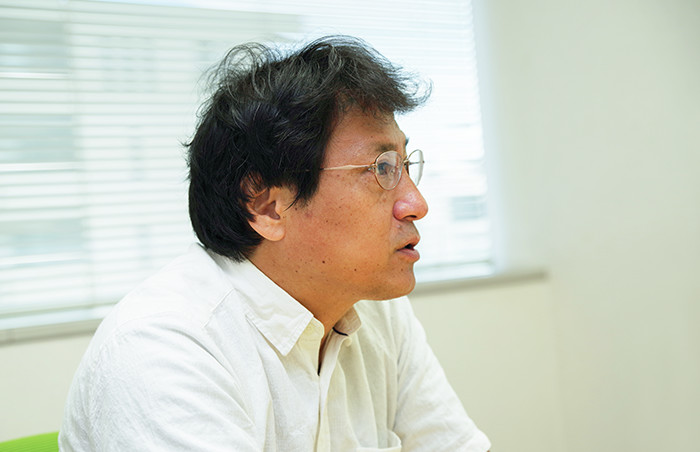
Ricoh Company Ltd. Smart Vision Business Group,
Product Development Center,
Product Planning Department
Ryoh Fukui
Fukui“Remote Playback” is a function that allows you to play videos and still images using THETA. As you know, THETA is a photographic device without a display. With camera models in the past, you had to transfer data to a smartphone or computer before you could view images and videos. This was a necessary step.
With THETA V, adding a function called “Remote Playback” enables you to directly display videos and still images on a display such as a TV. During the Remote Playback, the THETA V turns into a remote control, and you can use it to freely select images and also operate it to view 360-degree images. However, to use the Remote Playback, you have to separately purchase a dongle that provides wireless communication.
Could you identify what type of dongle is required?
FukuiA wireless reception terminal that plugs into an HDMI terminal on a TV such as a wireless display adapter that supports Miracast. It’s a system that receives wireless communication and mirrors the smartphone screen (displays the exact same screen). We plan to sequentially release information about compatible equipment on the THETA V support website.
People expect THETA to connect to a smartphone. This made us wonder how far we could take the camera if a smartphone wasn’t available. As a trial for this, we added a function to playback videos and images using the camera. This is the Remote Playback. It is a first in the history of THETA. It is also the world’s first function for consumer orientated spherical cameras (based on Ricoh research).
“Simple and easy to use. To achieve this THETA-like behavior and balance it with being multi-functional, we selected Plug-in.”
So, the Remote Playback is a function provided as a plug-in to extend the function of the camera.
TakadaTHETA is a very simple photographic device. It was developed as a camera with a single function that specialized in shooting 360-degree images. From the beginning when we sold the first camera model, we certainly received many requests from our users such as they said “It would be nice if we could also take 360-degree images in addition to taking normal photos”. However, we made a clear decision to make a product that could “just take 360-degree images”.
While deciding on this feature of simplicity, we also carefully researched and examined how to make the camera multi-functional and highly functional by evolving the hardware. Although, trying to add every desirable function would create problems in that it would become difficult to operate. So what can we do to balance the easy to use aspect with various functions? We arrived at the decision to use the plug-in, which is a software that adds new functions, to increase the camera’s extensibility.
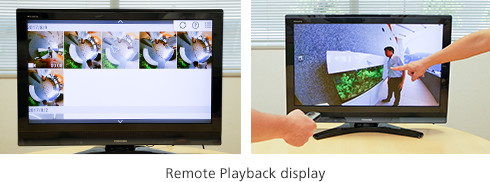
FukuiTHETA is freely customizable by adding functions you want to use through the use of plug-ins. We want to provide this kind of enjoyment to all of our users so we planned to have function extensions. From now we are planning to prepare a variety of Ricoh genuine plug-ins. The Remote Playback function, as the first plug-in, will be installed in the camera and provided by default.
So, it was inevitable that you decided on the plug-in for the Remote Playback.
TakadaAs I said earlier, we were not sure what would happen if we just went ahead and added every type of function to the camera. That’s my point. For example, just giving the camera the Remote Playback function, a single function, makes the procedure for using the camera increasingly difficult to understand. So, we thought it would be easier to use if we completely separated it from the functions of the camera and activate it as an extended function. We thought this would make it possible to add new functions while maintaining the ability to “quickly shoot images and quickly view them”, a feature of THETA passed on from the first camera model.
Fukui If people decide they “won’t use” the function, they can replace it with another function. I believe plug-ins increase the level of freedom for the user.
We have also been providing extended functions using firmware updates for THETA up until now. Actually this kind of extended function will add functionality to the camera. However, some users may not want some of the functions. This is why we thought it best to use plug-ins so that user can select which function to use or discard. As of now, with the popularity of smartphones, the situation is such that a culture has taken root in which people can decide for themselves which app they want to install. This is additional background on our decision to use plug-ins.
TakadaFunctions that we want most customers to use are put into the camera as main functions. We will prepare plug-ins separately for customers who show a strong demand for a function even if there are only a few of these customers. I think it’s best to think of it in these terms.
“The concept of a plug-in store, Similar to App Store and Google Play. Function extensions are the future of THETA.”
When did you first conceptualize function extensions?
FukuiWhen we planned THETA V so it was about one and a half years ago. We made significant changes to the internal system by supporting 4K video this time. The existing image processing engine was not powerful enough to record 4K video so we had to make a new engine. Along with this, we changed to a new operating system, and while thinking of ideas about what we could do, we came up with the idea of adding plug-ins.
What kind of procedure should users follow to add plug-ins?
FukuiWe are currently working on implementing a scheme for this. Until this is implemented, functions will be included in the firmware updates for the camera to add to the camera in the same way as for previous camera models. Eventually, we want to create a scheme in which users can select and add functions separately.
TakadaIt’s easier to understand if you imagine it to be like a smartphone App Store and Google Play. A concept to create a scheme where you can install a function at a plug-in store similar to those mentioned.
FukuiThe store concept is still a step ahead of us. As of now, we have not set a time for it.
What type of plug-ins will be released in the near future?
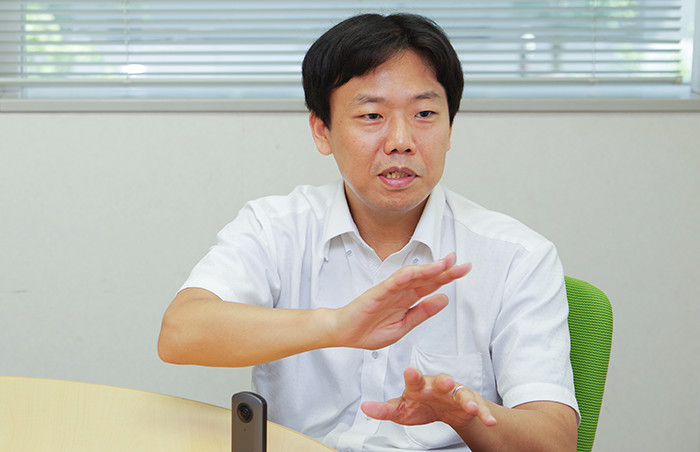
Ricoh Company Ltd. Smart Vision Business Group,
Data Service Business
Center,
Business Development Department
Masato Takada
TakadaI will tell you about this but it’s just at the concept stage. I think there are 3 directions we could go with plug-ins.
◎The 1st is extensibility that will “further enrich shooting images and videos”.
◎The 2nd is extensibility that will increase your ability to “connect with external devices”.
◎The 3rd is extensibility that will “connect the camera directly to a network”.
The Remote Playback, to be released first, is typical of extensibility that will increase your ability to “connect with external devices”. Another thing related to this is that we would like to produce a function that links to external memory. Previous models of THETA were unable to use memory such as SD cards. There was a high demand from all of our users for this but we passed on it to maintain a compact, lightweight, and simple design. Just adding a single card slot requires the camera body to be thicker. That’s because the components inside are packed so densely together.
Specifically, we plan to use the USB slot on the camera to connect to USB memory or an SD card reader to quickly transfer images and videos. We want to overcome the shortcomings of THETA up until this point using plug-ins. I was also in charge of planning the camera up until THETA SC and this was something I had always wanted to implement.
What about the “further enrich shooting images and videos” extension?
TakadaFirst, a function to shoot normal images that are not 360-degrees will probably be brought up. That is, shooting images using a single lens on THETA and narrowing the angle of view.
Also, a function that embeds a stamp-like image within the camera. THETA is a camera that will at times accidentally capture the photographer’s hand in the shot on a large scale. So, adding a stamp to hide their hand or something. This type of proposal came up.
We still have to talk about “connect the camera directly to a network” extensibility.
TakadaIf THETA could connect directly to the Internet, it would be possible to upload images and videos to the cloud the moment they were taken. We also provide a cloud service called “Keenai”. The biggest feature is to be able to save videos without any compression at all.
It is now possible to capture 4K video using THETA V. However, this means the size of files will be large. The method for saving videos will probably become an issue for all of our users. When this happens, we would like them to use “Keenai” as storage. We are thinking of adding a function that allows you to directly upload videos in the future.
“Users throughout the world can become a plug-in developer. We are working to support this.”
What are the hardships when developing function extensions?
TakadaI would say it’s building the architecture (the structure and design) more than anything. That’s because it’s brand-new and something that has not existed before. We are planning to support plug-ins developed by our users in the future. When the time comes, it will be necessary to develop and improve the architecture with the assumption that the plug-in is not created by Ricoh.
The user can become a plug-in developer?
TakadaTalking on a specialized level, THETA has released the API and SDK through developer websites in the past. That is, we provided a means of development support to people who say they “want to create smartphone apps”. This is also the same for plug-ins, it will not be at the same time as THETA V goes on sale but we plan to release the API and SDK when we can choose a good time to do so.
Around what time do you expect this to be?
TakadaThis is purely a personal goal but I would like to release them around spring 2018. At the stage they are released, they will be made available to everyone around the world.
What was the fun part of developing function extensions?
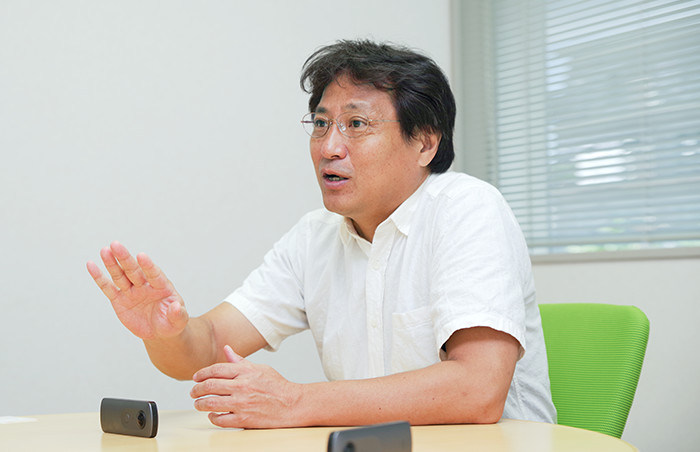
FukuiAs my job is in planning... I could set aside whether something can actually be achieved and ask “is it possible to do this?” to the development team. It was fun. Developers who I speak to probably thought “oh, not again” because they have to consider whether it can be done (laughs).
Among the ideas we have, I would definitely like to implement “connect the camera directly to a network” extensibility. For example, web cameras. We have them all over the world but they can all just as well be replaced with THETA. You will be able to see the scenery in all directions from faraway countries. You can also shoot and compose the scenery simultaneously using all cameras.
Conversely, we are also thinking of sharing a single THETA unit among several people. It will likely be possible to place THETA in the middle of a wedding location and shoot the scenes you want to shoot. It will be exciting to see what type of new experiences this will lead to in the future.
TakadaIn my opinion, something I expect for future development is that all our users throughout the world will be able to create a plug-in. I would be more than happy if somebody made a plug-in I could never have imagined. It would make me say “Wow, they came up with this concept!” I believe this would be the moment my own world extended.
“Combining THETA with a DSLR camera. Making it function as an eye centered on IoT. The possibilities are yet unknown.”
The possibilities for THETA seem to be extending more and more due to function extensions.
TakadaThis is a service we are considering in the distant future but I cannot say anything about its relationship with function extensions. We have been proposing a way of shooting images using THETA and a DSLR camera simultaneously by combining them. This is referred to as “Multi-imaging technology” and is a new technology at the stage of being reference exhibited at exhibition shows.
To explain what it is, it is equipment that connects THETA to a digital DSLR camera to shoot images with THETA at the same time as shooting images with the DSLR camera. After shooting images, the images shot with both types of equipment are automatically processed using a computer. This is a technology that allows you to display high resolutions when enlarging images because locations shot using the DSLR camera are composited in the 360-degree image.
Using this function will allow you to capture in a single shot an image displayed in the DSLR camera resolution of a subject you want to focus on from a 360-degree image as a whole.
What type of situation will this technology be useful?
TakadaI think it will be something you use every day. I would want to use it when shooting a scene with my children. The scene is important but what I want to have most is a clear photo of my children. There are things you will want to focus on in particular within an image shot in 360-degrees.
What do you want THETA to be in the near future?
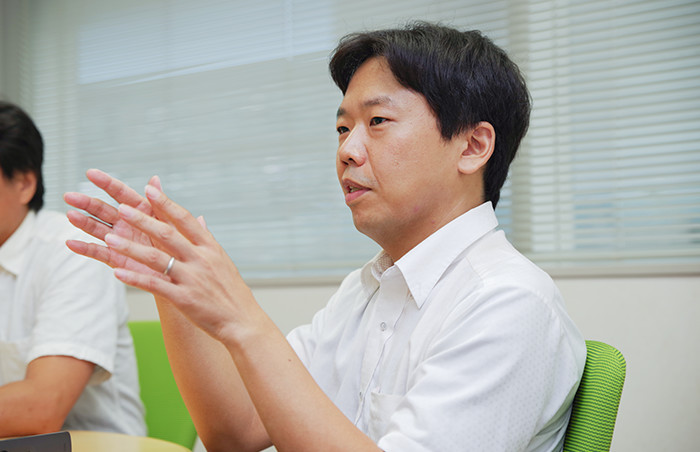
FukuiAn “eye” at the center of IoT (Internet of Things). It would be nice for THETA to be a type of device based on a cycle of THETA being used everywhere, people being able to share images and videos with everyone, and creating new value from this.
TakadaI have been involved in the development of all THETA models from the first camera model to the current one. Throughout the course of its development, I have been aiming to “create a new video culture”. I think development has been going so well up to THETA SC in regard to this. However, I also feel that it has not yet expanded enough.
With the current THETA V, we have implemented such things as adding 4K video, 360-degree spatial audio, and BLE (Bluetooth® Low Energy). Adding function extensions is sure to steadily expand THETA’s world view. It will probably show its presence more as a tool for creating a new video culture.
Profile
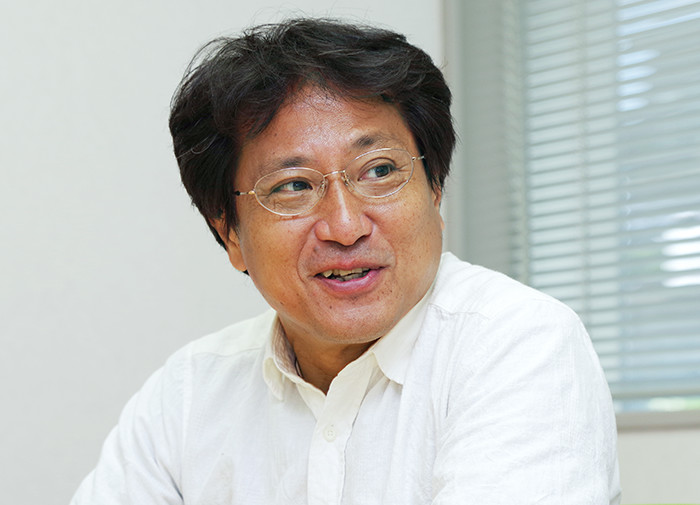
Ryoh Fukui
Ricoh Company Ltd.
Smart Vision Business Group
Product Development Center,
Product Planning Department
Joined Ricoh Company, Ltd. in 1986.
Worked on designing
semi-conductors at first. Transferred in 2000 to manage product planning for digital cameras such as the
GXR. On his days off, he enjoys playing tennis with friends he met online.
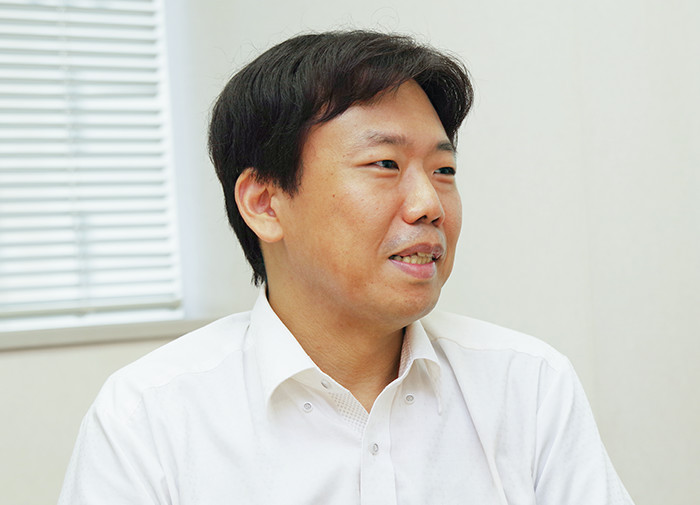
Masato Takada
Ricoh Company Ltd.
Smart Vision Business Group,
Data Service Business Center,
Business Development Department
Joined Ricoh Company, Ltd. in 1998.
Researched on precision mechanical engineering at his time at university. Worked on research and
development of user interfaces and is currently responsible for THETA app planning and product management.
His hobbies are raising his kids, golf, and watching baseball.
*The contents written in this interview is based on the information as of Sep. 15th, 2017